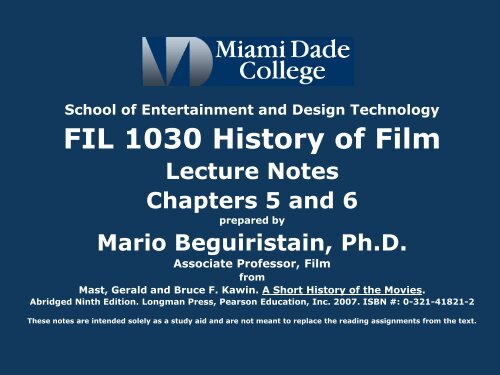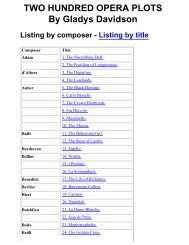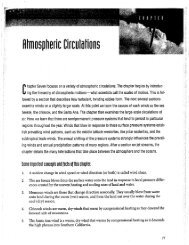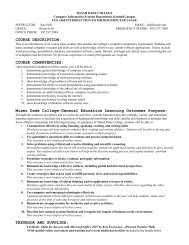FIL 1030 History of Film - MDC Faculty Home Pages
FIL 1030 History of Film - MDC Faculty Home Pages
FIL 1030 History of Film - MDC Faculty Home Pages
You also want an ePaper? Increase the reach of your titles
YUMPU automatically turns print PDFs into web optimized ePapers that Google loves.
School <strong>of</strong> Entertainment and Design Technology<br />
<strong>FIL</strong> <strong>1030</strong> <strong>History</strong> <strong>of</strong> <strong>Film</strong><br />
Lecture Notes<br />
Chapters 5 and 6<br />
prepared by<br />
Mario Beguiristain, Ph.D.<br />
Associate Pr<strong>of</strong>essor, <strong>Film</strong><br />
from<br />
Mast, Gerald and Bruce F. Kawin. A Short <strong>History</strong> <strong>of</strong> the Movies.<br />
Abridged Ninth Edition. Longman Press, Pearson Education, Inc. 2007. ISBN #: 0-321-41821-2<br />
These notes are intended solely as a study aid and are not meant to replace the reading assignments from the text.
The Motion Picture Patents Company<br />
� Controlled by Edison<br />
� Marketed one-hour programs <strong>of</strong> short films for Nickelodeons<br />
� Hired the Pinkerton Detective Agency to enforce their rights<br />
� Created the “Trust Wars” that resulted in filmmakers leaving NYC<br />
� Lost the public battle in the courts in 1917<br />
The New Producers<br />
Carl Laemmle, William Fox, Samuel Goldfish, Adolph Zukor,<br />
Jesse Lasky, Marcus Loew, Lewis J. Selznick and Louis B. Mayer<br />
� Produced two-hour feature films<br />
� Owned and built larger, more comfortable theaters fit for an<br />
evening’s entertainment<br />
� Jewish immigrants from Germany or Russia<br />
� <strong>Film</strong> was a new business without a controlling “clique”<br />
� Widely seen as a risky, illegitimate business; not for serious people<br />
Advertisement for<br />
Edison Motion Picture<br />
Equipment<br />
Edison with his invention<br />
Founders <strong>of</strong> the MPPC in 1906
Trenches <strong>of</strong> World War I<br />
The Three Silent <strong>Film</strong> Periods:<br />
1.1894-1907—Edison, Lumière & Méliès<br />
2.1908-1919—Griffith, Sennett & Chaplin<br />
3.1920-1929—Keaton, Gance, Murnau,<br />
Eisenstein & von Stroheim<br />
American <strong>Film</strong>s Rule:<br />
By 1914, American films, which had trailed after French<br />
and British films, establish their dominance <strong>of</strong> the world’s<br />
screens due to:<br />
1. World War I: Nitrate used in films was needed to<br />
make explosives<br />
2. The films <strong>of</strong> Griffith, Sennett Chaplin and Pickford<br />
3. The Star System: Names draw in the crowds<br />
4. The Studio System: The industrial approach to<br />
filmmaking<br />
The Three Tiers <strong>of</strong> the<br />
American <strong>Film</strong> Business:<br />
1. Production: Studios located in Hollywood<br />
2. Management and Distribution: In New York<br />
3. Exhibition: Theaters throughout the land<br />
Mary Pickford
The Star System<br />
� Biograph opposed giving actors<br />
screen credit because then they<br />
would ask for more money.<br />
� The Biograph Girl, Florence Lawrence,<br />
was hired away by Carl Laemmle in 1910<br />
who promised to feature her name.<br />
She became “The First Movie Star.”<br />
� Movie stars do not play characters as they are characters themselves.<br />
� In 1912 Photoplay Magazine begins national publication.<br />
� Studio Publicity Departments are created to feed stories to the press.<br />
� The Movie Star Gossip Mill begins grinding.<br />
Florence Lawrence<br />
In 1915 Fox manufactures a “star”<br />
Theda Bara--actually Mrs. Theodocia<br />
Goodman, a housewife from Cincinnati.<br />
Known as the first “vamp,” her screen<br />
name was an acronym for “Arab Death.”
Mack Sennett<br />
Began directing shorts for Edison, then went to Biograph, and later founded Keystone, his own production company.<br />
1. Sennett’s comedy was achieved by:<br />
� Making humans look like machines<br />
� Using fast motion (under-cranking)<br />
� Moving and flying props (invented pie fight)<br />
� Cross-cutting, chases and cliffhangers<br />
2. The Keystone Kops:<br />
� Ridiculed the police<br />
� An ensemble where no actor stood out<br />
� Training ground for many silent comics<br />
3. “Tillie’s Punctured Romance” (1914)<br />
� First feature-length comedy, six reels long<br />
� First pairing <strong>of</strong> Marie Dressler with Chaplin<br />
� A big hit!
Charles Chaplin<br />
1. Tours the U.S. with Fred Karno’s British Music Hall Troupe<br />
2. In December <strong>of</strong> 1913 reluctantly joins Keystone Studios<br />
3. Brought character and individuality to Sennett comedies<br />
4. Phenomenal rise: from $7,200 a year in 1914 to $1 Million a year in 1917<br />
5. The World is serious and mean; social structures keep you in your place<br />
6. Develops “The Little Tramp” character<br />
7. Uses pathos as counterpoint to comedy<br />
8. First International Superstar<br />
Characteristics <strong>of</strong> “The Little Tramp”<br />
a) An outsider/ an immigrant/ a worker<br />
b) Longs for respect, love, money, social status<br />
c) Goes to the very depths <strong>of</strong> comedic situations<br />
d) Optimistic in spite <strong>of</strong> incredible hardship<br />
e) Kind/ generous <strong>of</strong> heart<br />
f) Protector <strong>of</strong> women and children<br />
g) Comments on the values <strong>of</strong> society<br />
h) Ingenious use <strong>of</strong> props in gags
Movie Palaces are built…<br />
The “ugly duckling” Nickelodeons<br />
are transformed into extravagant<br />
Palaces with thematic architecture:<br />
Atmospheric, Arabian,<br />
Egyptian, Rococo,<br />
Spanish Mediterranean, etc.<br />
� The Roxy in New York<br />
� Grauman’s Chinese in Los Angeles<br />
� Grauman’s Egyptian in Los Angeles<br />
� The Fox in Atlanta and Oakland<br />
� The Loew’s Ohio in Columbus<br />
� The Olympia in Miami, etc.<br />
Here, any modest-income<br />
family could spend a whole<br />
day watching movies in the<br />
lap <strong>of</strong> luxury.
By 1915 most <strong>of</strong> the film companies had<br />
settled in Los Angeles, CA because <strong>of</strong>:<br />
� The Trust Wars: Proximity <strong>of</strong> Mexican Border<br />
made for and easy and quick get-away<br />
� Excellent weather with lots <strong>of</strong> sunshine<br />
� Topography: a wide variety <strong>of</strong> natural scenery<br />
� Cheap real estate to build big studios<br />
In 1919, Charlie Chaplin, Mary Pickford, Douglas Fairbanks and D.W. Griffith found their own production,<br />
distribution and exhibition company: UNITED ARTISTS.<br />
“Now the lunatics are running the asylum”<br />
--Typical Hollywood reaction
Hal Roach Studios:<br />
Where Silent Comedy Was King<br />
receiving his<br />
Honorary Oscar<br />
in 1984<br />
Achieved immortality in TV syndication<br />
as “the Little Rascals”<br />
Baby-faced innocent<br />
The greatest comedienne<br />
The greatest comedy duo <strong>of</strong> all time<br />
Urbane, sophisticated, college guy
Movies and Morality:<br />
Scandals and the Threat <strong>of</strong> Censorship<br />
Movies start to be seen by many religious groups as lewd and<br />
licentious spectacles bent on corrupting American youth and morality.<br />
When movie stars become role models, their private lives come under<br />
public scrutiny.<br />
In 1921, Fatty Arbuckle was involved in two scandals:<br />
� Making a pay<strong>of</strong>f to a Massachusetts politician<br />
� Arrested and accused <strong>of</strong> the murder <strong>of</strong><br />
“actress” Virginia Rappé at a raucous<br />
Labor Day Party in San Francisco’s<br />
St. Francis Hotel.<br />
After a lengthy trial that was widely covered<br />
by the media, Arbuckle was found innocent;<br />
but it was too late. His career had already<br />
been destroyed.<br />
In 1922, former Postmaster General<br />
Will Hays, is hired to head the Motion<br />
Picture Producers Association (MPPA)<br />
and to “police” Hollywood.<br />
For eight years, Hays would “put the lid”<br />
on many <strong>of</strong>f-screen scandals, but it wasn’t<br />
until 1930 that the Catholic Legion <strong>of</strong> Decency<br />
forced him to write and enforce<br />
The Production Code.<br />
Virginia Rappé<br />
Will Hays
Cecil B. De Mille<br />
Finds in the scriptures an endless source <strong>of</strong><br />
audience titillation above moral reproach.<br />
Though best remembered for his Biblical Epics,<br />
De Mille excelled in other genres, including the<br />
Western, Sea Adventure and Comedy <strong>of</strong> Manners.<br />
The Ten Commandments, 1956<br />
The Sign <strong>of</strong> the Cross, 1932 Manslaughter, 1922<br />
Don’t Change Your Husband, 1918
Erich von Stroheim (The man you love to hate)<br />
� Austrian Actor,Writer, Producer and Director<br />
� Obsessed with total realism down to every detail<br />
� Made Old-World melodramas about infidelity and deception<br />
� Constantly fought with movie executives, especially Thalberg<br />
� His excesses caused him to be blacklisted in Hollywood<br />
“Blind Husbands” 1919<br />
“Foolish Wives” 1921<br />
“The Wedding March” 1928<br />
Directing “Greed” in 1924<br />
� In the naturalist tradition <strong>of</strong> Zola<br />
� Ran 9 hours at first screening<br />
� Legendary lost masterpiece
1922<br />
Robert Flaherty<br />
� Father <strong>of</strong> the Feature Documentary <strong>Film</strong><br />
� Anthropology proves to be a big box <strong>of</strong>fice attraction<br />
1931<br />
“The Land” 1942<br />
1934<br />
1948
Buster Keaton<br />
1. Insight: both funny and serious<br />
2. Deadpan—the great stone face<br />
3. Irreverent to women<br />
4. No pathos<br />
5. Elaborate gags that build up<br />
6. Buster goes about his business while<br />
the world around him is going mad<br />
7. Narrative, not character, is the driving<br />
force <strong>of</strong> his films
Buster Keaton’s<br />
“The General” (1927)<br />
� Civil War background<br />
� A journey, an epic story, the Odyssey<br />
� He suffers hardships and adventures<br />
on his way back home<br />
� Turns obstacles into tools<br />
� Most expensive scene in silent films
<strong>FIL</strong> <strong>1030</strong> <strong>History</strong> <strong>of</strong> <strong>Film</strong><br />
Lecture Notes<br />
Chapters 5 and 6<br />
“The End”<br />
If you wish to continue with the next chapters:<br />
1. Click on your browser’s “back” button to return to the syllabus<br />
2. Click on the button at the top <strong>of</strong> the syllabus for the next chapters













